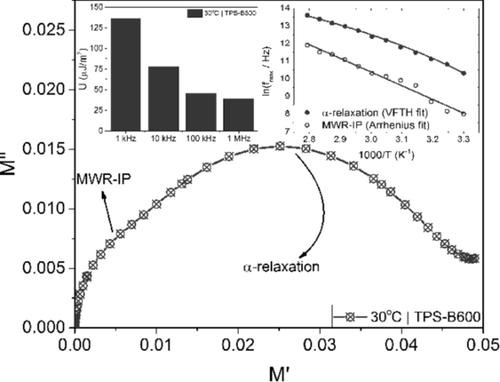当前位置:
X-MOL 学术
›
J. Appl. Polym. Sci.
›
论文详情
Our official English website, www.x-mol.net, welcomes your
feedback! (Note: you will need to create a separate account there.)
The effect of micro‐fibrillated cellulose upon the dielectric relaxations and DC conductivity in thermoplastic starch bio‐composites
Journal of Applied Polymer Science ( IF 2.7 ) Pub Date : 2020-07-03 , DOI: 10.1002/app.49573 Stavros X. Drakopoulos 1, 2 , József Karger‐Kocsis 3, 4 , Georgios C. Psarras 1
Journal of Applied Polymer Science ( IF 2.7 ) Pub Date : 2020-07-03 , DOI: 10.1002/app.49573 Stavros X. Drakopoulos 1, 2 , József Karger‐Kocsis 3, 4 , Georgios C. Psarras 1
Affiliation

|
Thermoplastic starch (TPS) bio‐composites were prepared with natural rubber latex (NR) and/or cellulose microfibers of variable size, as reinforcements. The relaxation processes are investigated via broadband dielectric spectroscopy in a broad temperature and frequency range. By means of the electric modulus formalism, the dynamic glass‐to‐rubber transition process of the starch‐rich regions in TPS (α‐relaxation), and the presence of water molecules at the interfaces between the TPS matrix and the fillers (MWR‐IP), is observed and discussed. The dielectric behavior and energy storage were found to be affected by the presence of the aforementioned water molecules, hindering the polarizability of the samples due to hydrogen bonding with the hydrophilic constituents. Following the temperature dynamics of the α‐relaxation, good adhesion between the TPS matrix and the cellulose microfibers was revealed, although the addition of natural rubber latex microparticles has the opposite effect attributed to their hydrophobic character. Finally, the dc conductivity was estimated from the ac dielectric spectra with a new mathematical formulation that is introduced here, and showed nonlinear temperature dependence for all the samples under study. The purpose of this study is to investigate the use of biodegradable eco‐friendly thermoplastic starch bio‐composites as dielectric materials for capacitor applications. Microfibrillated cellulose and/or natural rubber latex are employed as reinforcements and insight upon their dielectric relaxation behavior is provided by broadband dielectric spectroscopy in a broad temperature and frequency range.
中文翻译:

微纤化纤维素对热塑性淀粉生物复合材料介电弛豫和直流电导率的影响
热塑性淀粉(TPS)生物复合材料是用天然橡胶胶乳(NR)和/或大小可变的纤维素微纤维作为增强材料制备的。通过宽带介电谱在较宽的温度和频率范围内研究了弛豫过程。通过电子模量形式,TPS中富含淀粉区域的玻璃到橡胶的动态转变(α松弛),以及TPS基质与填料之间的界面处存在水分子(MWR- IP),进行观察和讨论。发现介电行为和能量存储受上述水分子的存在影响,由于氢与亲水性成分的键合而阻碍了样品的极化性。遵循α松弛的温度动态,尽管添加了天然橡胶胶乳微粒具有相反的作用,这归因于其TPS基质与纤维素微纤维之间的良好粘合性,但它们具有疏水性。最后,采用本文介绍的新数学公式,根据交流电介质光谱估算了直流电导率,并显示了所有研究样品的非线性温度依赖性。本研究的目的是研究可生物降解的环保型热塑性淀粉生物复合材料作为电容器应用的介电材料的用途。使用微纤化纤维素和/或天然橡胶胶乳作为增强材料,宽带介电谱在较宽的温度和频率范围内提供了有关其介电弛豫行为的见解。
更新日期:2020-07-03
中文翻译:

微纤化纤维素对热塑性淀粉生物复合材料介电弛豫和直流电导率的影响
热塑性淀粉(TPS)生物复合材料是用天然橡胶胶乳(NR)和/或大小可变的纤维素微纤维作为增强材料制备的。通过宽带介电谱在较宽的温度和频率范围内研究了弛豫过程。通过电子模量形式,TPS中富含淀粉区域的玻璃到橡胶的动态转变(α松弛),以及TPS基质与填料之间的界面处存在水分子(MWR- IP),进行观察和讨论。发现介电行为和能量存储受上述水分子的存在影响,由于氢与亲水性成分的键合而阻碍了样品的极化性。遵循α松弛的温度动态,尽管添加了天然橡胶胶乳微粒具有相反的作用,这归因于其TPS基质与纤维素微纤维之间的良好粘合性,但它们具有疏水性。最后,采用本文介绍的新数学公式,根据交流电介质光谱估算了直流电导率,并显示了所有研究样品的非线性温度依赖性。本研究的目的是研究可生物降解的环保型热塑性淀粉生物复合材料作为电容器应用的介电材料的用途。使用微纤化纤维素和/或天然橡胶胶乳作为增强材料,宽带介电谱在较宽的温度和频率范围内提供了有关其介电弛豫行为的见解。











































 京公网安备 11010802027423号
京公网安备 11010802027423号